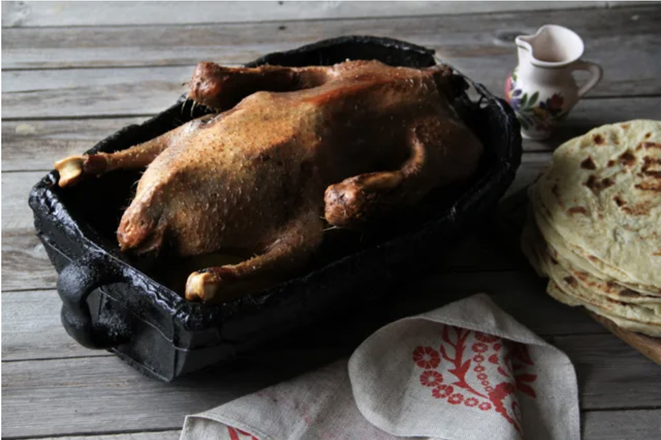Autumn is traditionally the time in Slovakia for taking part in celebrations with roast goose or duck. Restaurants hang banners declaring husacie hody (goose festival) or sometimes kačacie hody (duck festival). A town in western Slovakia, Slovenský Grob, has made a name for itself as the place for roast goose.
When looking to buy a goose (hus) or duck (kačica) you might come across what is called a husokačka. It sounds like it is a cross between a goose and a duck, but it is actually a cross between two different types of ducks, called a mulard or moulard in English. Mulards have a good amount of meat, and less fat than a traditional duck.
When choosing the type of poultry, keep in mind that a duck is more fatty, a mulard less fatty, and a goose still less so. Duck is the most tender meat, however, and goose can get a little tough.
The Slovak way of roasting these poultry is simple but results in tasty, juicy meat and crispy skin. The night before, rub the whole bird generously in salt and let sit overnight. The water in the meat is first drawn out by the salt but then gets reabsorbed, bringing salt with it. The salt then increases the flavour as well as breaking down the protein, resulting in a more tender meat.
Roasted goose and duck are traditionally served with lokše, potato flatbread, which you can make yourself or buy. Along smaller roads, in small towns you can sometimes find tables outside private homes with a babička selling homemade lokše.
Both fowl release a fair amount of fat. Hot schmaltz is brushed onto lokše, otherwise they can be quite dry. Once the fat is cool, a traditional way of using it is spread thickly on bread, which is then sprinkled with sliced onion and salt. Otherwise, use it as you would any cooking fat. It is also used to cure a cough!


 Roast goose with lokše (source: Naomi Hužovičová)
Roast goose with lokše (source: Naomi Hužovičová)